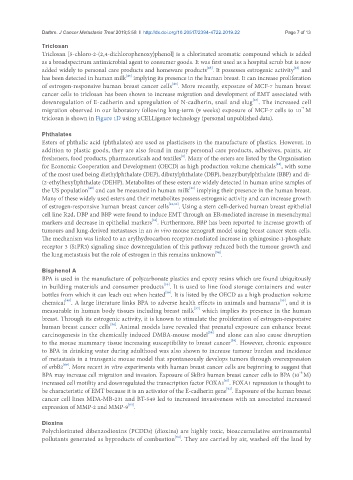Page 394 - Read Online
P. 394
Darbre. J Cancer Metastasis Treat 2019;5:58 I http://dx.doi.org/10.20517/2394-4722.2019.22 Page 7 of 13
Triclosan
Triclosan [5-chloro-2-(2,4-dichlorophenoxy)phenol] is a chlorinated aromatic compound which is added
as a broadspectrum antimicrobial agent to consumer goods. It was first used as a hospital scrub but is now
[45]
[46]
added widely to personal care products and homeware products . It possesses estrogenic activity and
[45]
has been detected in human milk implying its presence in the human breast. It can increase proliferation
of estrogen-responsive human breast cancer cells . More recently, exposure of MCF-7 human breast
[45]
cancer cells to triclosan has been shown to increase migration and development of EMT associated with
downregulation of E-cadherin and upregulation of N-cadherin, snail and slug . The increased cell
[47]
-7
migration observed in our laboratory following long-term (9 weeks) exposure of MCF-7 cells to 10 M
triclosan is shown in Figure 1D using xCELLigence technology (personal unpublished data).
Phthalates
Esters of phthalic acid (phthalates) are used as plasticisers in the manufacture of plastics. However, in
addition to plastic goods, they are also found in many personal care products, adhesives, paints, air
[1]
fresheners, food products, pharmaceuticals and textiles . Many of the esters are listed by the Organisation
for Economic Cooperation and Development (OECD) as high production volume chemicals , with some
[48]
of the most used being diethylphthalate (DEP), dibutylphthalate (DBP), benzylbutylphthalate (BBP) and di-
(2-ethylhexyl)phthalate (DEHP). Metabolites of these esters are widely detected in human urine samples of
[49]
[50]
the US population and can be measured in human milk implying their presence in the human breast.
Many of these widely used esters and their metabolites possess estrogenic activity and can increase growth
of estrogen-responsive human breast cancer cells [51,52] . Using a stem cell-derived human breast epithelial
cell line R2d, DBP and BBP were found to induce EMT through an ER-mediated increase in mesenchymal
[53]
markers and decrease in epithelial markers . Furthermore, BBP has been reported to increase growth of
tumours and lung-derived metastases in an in vivo mouse xenograft model using breast cancer stem cells.
The mechanism was linked to an arylhydrocarbon receptor-mediated increase in sphingosine-1-phosphate
receptor 3 (S1PR3) signaling since downregulation of this pathway reduced both the tumour growth and
[54]
the lung metastasis but the role of estrogen in this remains unknown .
Bisphenol A
BPA is used in the manufacture of polycarbonate plastics and epoxy resins which are found ubiquitously
[55]
in building materials and consumer products . It is used to line food storage containers and water
bottles from which it can leach out when heated . It is listed by the OECD as a high production volume
[56]
[55]
[48]
chemical . A large literature links BPA to adverse health effects in animals and humans , and it is
[57]
measurable in human body tissues including breast milk which implies its presence in the human
breast. Through its estrogenic activity, it is known to stimulate the proliferation of estrogen-responsive
human breast cancer cells . Animal models have revealed that prenatal exposure can enhance breast
[56]
[58]
carcinogenesis in the chemically induced DMBA-mouse model and alone can also cause disruption
[59]
to the mouse mammary tissue increasing susceptibility to breast cancer . However, chronic exposure
to BPA in drinking water during adulthood was also shown to increase tumour burden and incidence
of metastasis in a transgenic mouse model that spontaneously develops tumors through overexpression
[60]
of erbB2 . More recent in vitro experiments with human breast cancer cells are beginning to suggest that
BPA may increase cell migration and invasion. Exposure of SkBr3 human breast cancer cells to BPA (10 M)
-8
[61]
increased cell motility and downregulated the transcription factor FOXA1 . FOXA1 repression is thought to
[62]
be characteristic of EMT because it is an activator of the E-cadherin gene . Exposure of the human breast
cancer cell lines MDA-MB-231 and BT-549 led to increased invasiveness with an associated increased
[63]
expression of MMP-2 and MMP-9 .
Dioxins
Polychlorinated dibenzodioxins (PCDDs) (dioxins) are highly toxic, bioaccumulative environmental
[64]
pollutants generated as byproducts of combustion . They are carried by air, washed off the land by

